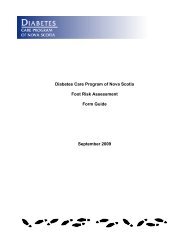CDE Appendix 1 Literature Review - Central East Local Health ...
CDE Appendix 1 Literature Review - Central East Local Health ...
CDE Appendix 1 Literature Review - Central East Local Health ...
Create successful ePaper yourself
Turn your PDF publications into a flip-book with our unique Google optimized e-Paper software.
The Culture, Diversity and Equity Project: <strong>Literature</strong> <strong>Review</strong><br />
To ensure system-wide compliance and accountability, health equity policies and strategies should be integrated into<br />
existing performance management systems. In this regard, health equity impact assessments are a promising tool for:<br />
• ‘Mainstreaming’ accountability across an entire organization (versus siloing responsibility only with<br />
specialists); and<br />
• Ensuring that all policy/program areas consider the impact of their interventions on various diverse groups (not<br />
just the one that the policy/program is focused on).<br />
Policies should also be monitored by a corporate level oversight body to assure and monitor progress and coordinate<br />
efforts for eliminating disparities.<br />
The Role of the LHINs<br />
The major ‘levers’ currently available to the LHINs for managing performance are their:<br />
• Funding and allocation powers;<br />
• <strong>Local</strong> health system planning and contracting role (e.g., Integrated <strong>Health</strong> Service Plans; LHIN-Provider service<br />
accountability agreements etc.); and<br />
• Potential oversight role regarding compliance with health equity policy objectives as reflected in service plan<br />
agreements.<br />
Establishing accountability and quality assurance depends on continuing measurement, evaluation, and reporting of<br />
progress in relation to health equity policy objectives. As part of its service plan agreements, the LHIN can, for<br />
instance, require:<br />
• Annual targets per health equity policy goals and objectives;<br />
• Ongoing performance monitoring and control action; and<br />
• Regular reporting on progress to both the LHIN and the public (e.g., annual report cards).<br />
The LHINs could play a critical role in delivering the capacity that makes compliance possible:<br />
• Provide and/or support training initiatives;<br />
• Develop health equity/cultural competence ‘guidelines’ and standards for care; and<br />
• Assist and coordinate existing health equity researchers and research units in intelligence gathering and<br />
exchanges.<br />
The health care system’s licensing and accreditation agencies, although beyond the direct control of the LHINs, can<br />
also play a quality assurance role. For example, they could require health care providers to meet health<br />
equity/cultural competence ‘standards’ as a condition of licensing and/or accreditation (Exworthy et al., 2006;<br />
Betancourt et al., 2002; Office of Minority <strong>Health</strong>, 2001).<br />
Part 3: Cultural Competence Education and Training<br />
While there is significant variation in the specific content of cultural competence training initiatives, they tend to<br />
focus on three main areas:<br />
• Attitudes;<br />
• Knowledge; and<br />
• Skills (Sue et al., 1992, 1996; Curtis, Dreachslin, & Sinioris, 2007; California Endowment, 2003; Haarmans,<br />
2004).<br />
7

















